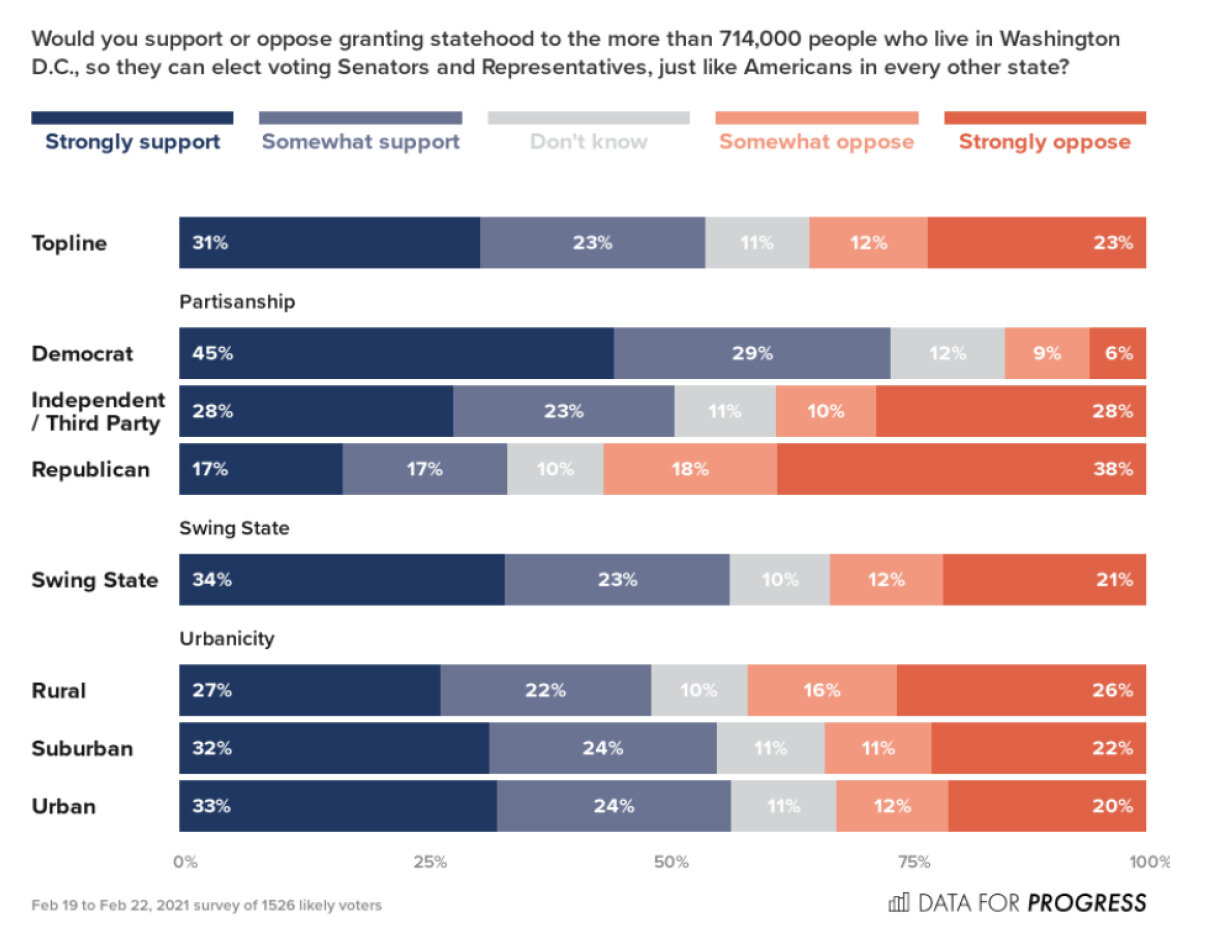D.C. Statehood
Critical Analysis
According to the data in the chart above, identify the portion of Republicans strongly support D.C. statehood?
According to the data in the chart above, overall, do more Americans support or oppose D.C. statehood?
According to the data in the chart above, identify which demographic group is most supportive of D.C. statehood.
Based only on the data from the chart above, explain how likely it is that D.C. will become a state.
The roughly 700,000 residents of Washington, D.C., have no voting representation in Congress -- yet pay more taxes per capita than anyone else in the U.S. In June 2020 (last summer), the House of Representatives voted for the first time ever to turn the nation’s capital into its 51st state. The bill that passed the House would name the new state Washington Douglass Commonwealth after former city resident and abolitionist Frederick Douglass. Federal buildings, including the White House and Capitol, would remain a separate federal district, still called the District of Columbia. The city would gain two senators, one voting member of the House and control over its own decisions. Currently, Congress can overrule local officials. The bill failed to pass the next few steps necessary to make D.C. statehood a reality. Based on your knowledge of American politics, explain whether, less than a year later, D.C. is now more likely to become a state.
Vermont and Wyoming are both smaller than D.C. and both have House members and Senators. But when The District of Columbia was established 230 years ago by Congress, it was set up to be a unique entity, not to be part of any state. The last state to join the Union was Hawaii. Describe the process by which Hawaii become a state?
The Constitution grants general state-creation powers to Congress in Article IV, Section 3, under the Admissions Clause, which reads: “New States may be admitted by the Congress into this Union; but no new State shall be formed or erected within the Jurisdiction of any other State; nor any State be formed by the Junction of two or more States, or Parts of States, without the Consent of the Legislatures of the States concerned as well as of the Congress.” Explain whether this constitutional provision outlaws D.C. statehood.
Just because a majority of Americans support D.C. statehood, does not mean that D.C. statehood automatically happens. Imagine we lived in a system where we took polls and surveys on all public policy issues with the majority vote translating into policy. Explain whether you would want to live in this type of system.
In the data in the chart above, respondents were told that statehood would give congressional voting representation to more than 714,000 Washingtonians, “just like Americans in every other state,” (which is true) so this question framing likely primed respondents to be more favorable toward statehood. A different poll on D.C. statehood from Rasmussen Reports* (see below) was taken at roughly the same time and found that only 29% of Americans supported D.C. statehood, while 55% opposed it. In the Rasmussen poll respondents were told that the U.S. Constitution designates the nation’s capital as a federal district, not a state, (which is also true) which may have primed respondents to oppose statehood. Explain how the wording of a question on the same topic can lead to different answers and opinions.* (see data below)
Based on the fact that different pollsters can find divergent results on the same topic, explain how important public opinion polling is in American politics.
Based on your knowledge of American politics, explain how D.C. statehood would upset the current balance of power in the U.S.
Overall, explain whether you support D.C. statehood.
Learning Extension
Watch this rated NC 17 video from PBS NewsHour about how D.C. could become a state.
Action Extension
Contact your U.S. freaking Senator and let them know what you think of D.C. statehood.
Visual Extension
Prepare for the 2026 AP® US Government Exam with High Five! Our Exam Review guide is completely redesigned and updated with over 140 pages of great AP Exam review material. Tons of completed graphic organizers are full of information to get you exam-ready in a flash.
This 2026 exam guide is an instant download and contains all the following resources.
Overview of the U.S. Government and Politics exam.
Completed graphic organizers for all required documents + Supreme Court cases.
Guide to the skills and content for all 5 course units.
Essential vocabulary with link to online glossary.
Tons of Graphic Organizers with answers from each course unit.
GoPo Pro Tips and checklists.
Exam review Guides.
Amazing AI generated images of the Framers of the Constitution giving high fives!
Full Length AP multiple choice + Free Response Exam with Key.
AP ® is a trademark registered by the College Board, which is not affiliated with, and does not endorse, this site or product.
GoPoPro does not offer credit or grades for our classes or products.
PREVIEW HIGH FIVE NOW



